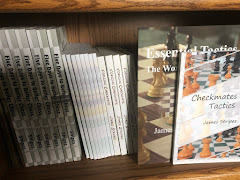1. Reduce Online Blitz
2. Intensify Endgame Training
3. Demand Consistency in Tactics Training Plus
Online Blitz
Without revealing how much blitz I've been known to play certain days, I am renewing a pledge I made two years ago to limit this drug to five games per day. As most of my online blitz is 3 0, five games devour less than thirty minutes, and only rarely close to that much time.
Robert Pearson is one among many notable bloggers that have decried the evil that results from online blitz addictions. He advocates giving up blitz (again).
Blitz fuels a chemical addiction. These chemicals--endorphins--are produced in the brain, and give distance runners a euphoric high, or draw other people towards extreme sports. Indeed, internet blitz differs from certain other chemical addictions only insofar as it is less damaging to the throat, lungs, and liver. Whether it is better or worse than bungee jumping and marathon running depends on whether one succeeds in keeping other aspects of life in balance.
Substitution is often the best way to remove a destructive habit. With respect to internet blitz, two excellent alternatives have worked for me in the past: longer online games, and correspondence or turn-based chess. Instead of playing 3 0 games one after the other, the time I spend at the Playchess server can be employed playing 16 0 to 25 0 games. The playing session still requires less than half a day, but there's time for strategic planning and some efforts towards accurate calculation. Even more effective is to reduce the time online. At any given time, I usually have from a half-dozen to two dozen games going at Chess World, Chess.com, and Red Hot Pawn. Sometimes I move carelessly due to haste (a consequence of too much blitz). Greater attention to the "quest for chess truth" in these games requires such attention that it leaves little time for live online play.
Endgame Training
Followers of Chess Skills well know that I advocate simplification of complex positions into easily won pawn or even rook endgames. In "Elementary Positions" and a few subsequent posts, I've discussed positions in Laszlo Polgar's massive collection. In the 318 "elementary positions," the first two are basic heavy piece checkmates. Then, number 3 through 99 are pawn endgames. It is my intention to finish these pawn endgames in January, then play against the computer the 100 in Finali di Pedone II from DejaScacchi (there may be some duplicates), followed by working through the other 219 elementary positions in Polgar's book. This endgame work should be finished prior to summer. At that point, further study of Dvoretsky's Endgame Manual and Silman's Complete Endgame Course may be in order.
Consistency
Last June I put forth a resolution regarding tactical training and the consequent development of technique. In this endeavor, I have been inconsistent, averaging about half of that time, but missing many weeks. In 2009, I resolve to find these ninety minutes every week. Most often, this training will focus upon the positions in Fred Reinfeld, 1001 Winning Chess Sacrifices and Combinations, but from time to time will include play from problems in Paata Gaprindashvili, Imagination in Chess, or other texts.
Rating History
I crossed over 1600 into the B Class in late 2005 and climbed steadily to 1722 by February 2007, but then dropped below 1700 later that month. I next crossed 1700 on the way up in March this year, have maintained my rating in the 1700s since then, and am ending the year at 1722. In 2007, 1722 was my peak; in 2008 it has served as a valley.
When I started playing USCF tournaments in the mid-1990s, I established a rating in C Class, nearly won my section of the Washington Class Championship (see diagram), and only dipped into D Class through one dark period following my stellar 0-5 record in the 1998 Collyer Memorial Tournament. Five months and three tournaments later, I was back in the 1400s, but it took me seven years to climb out of C.
In round four on board one in the 1996 Washington Class Championship, I had this position and the move.
Black to move -+
I considered, but did not play the key move here. Since then, I've played it and defeated Chessmaster, Fritz, and Hiarcs. A win in this game would have guaranteed a tie for first, which is what my opponent earned as a consequence of my failure. Had I won this game, my first published established rating would have been in the mid-1500s. As a result of the loss (and the subsequent game), it was 1495. Instead of winning my section, I tied for places 8-15, and am listed as 15th in the crosstable.
In 2008, I played for the Spokane City Championship. In that match I earned my first rated draw with a chess master. I'd like to add some more scalps in 2009.










